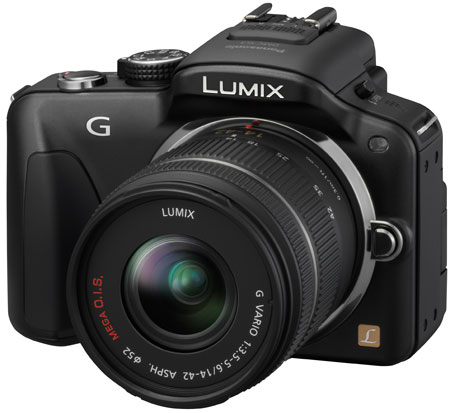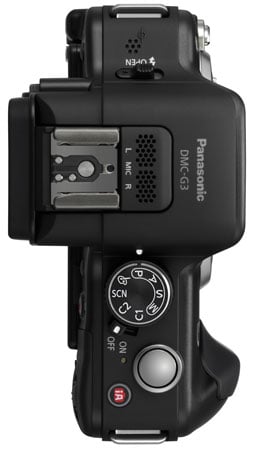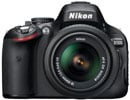Panasonic Lumix DMC-G3
-
-
Written by Gordon Laing
Verdict
The Panasonic Lumix DMC-G3 is one of the most satisfying and enjoyable cameras I’ve used. It’s sufficiently small and light to be carried almost anywhere without compromising comfort or ergonomics. It has a fully-articulated screen for easy composition at unusual angles or a high quality electronic viewfinder for times when you’d prefer the camera held to your face.
It sports an excellent touch-screen interface, backed-up by a selection of physical buttons for those who prefer traditional controls. The contrast-based AF system is very snappy, giving the camera a very responsive feel which pans the Live View handling on most DSLRs. And last but by no means least, the image and video quality is right up there with the best APS-C DSLRs.
While the flagship Lumix GH2 may out-feature it in a number of specialist regards, Panasonic has sensibly balanced the capabilities of the G3 so not to tread on the toes of the higher-end model but equally not feel hobbled in any way. This has crucially allowed the G3 to hit a lower price point which makes it look very competitive compared to traditional DSLRs with similar capabilities. It is in short, one of the most successful Micro Four Thirds models to date, indeed one of the best mirrorless EVIL cameras of any standard, and deserves to sell very well.
|  |
I genuinely believe many people who are shopping for their first DSLR would be better-served by something like the Lumix G3. The 100% Live View system may put-off traditionalists who desire an optical viewfinder, but it really does have many benefits for photographers of all capabilities. First, the metering and AF system are not limited to a handful of fixed areas and points. In contrast they can evaluate the entire image, allowing very effective scene and face detection.
These cannot be under-estimated. A good face detection system can not only identify a human face but lock onto the eyes in a fraction of a second. All it then needs is a sufficiently quick contrast-based AF system to drive the lens to the right point for a technically perfect portrait shot. This is where traditional DSLRs fall down as while their face detection algorithms are perfectly good, they don’t have a quick enough AF system in Live View to exploit the tracking. Sony’s SLT cameras solve the speed with their phase-change AF system, but it’s limited to fixed points on the frame, and if the face, or more specifically an eye, doesn’t fall below one of them, it’s not going to deliver the desired result.
 | |
Literally in contrast, the Lumix G3 is equipped with one of the quickest contrast-based AF systems on the market, allowing its numerous AF modes to lock-onto and sharply focus the desired subject in an instant. In a situation where you’re photographing friends or kids where the subjects don’t stand still for long, the G3 can simply lock-onto them faster than most DSLRs, without worrying about their position on the frame. No locking the focus, re-composing or delay, just take the photo confident in the knowledge it’ll almost always be successful.
I really put this to the test by fitting the G3 with the Leica DG Summilux 25mm f1.4 lens and photographing close portraits at a three-year-old’s birthday party with the aperture set to f2 or wider. The shallow depth-of-field coupled with subjects that wouldn’t sit still for long would normally have been a recipe for disaster, but the G3 enjoyed a very high success rate.
It’s also worth remembering a contrast-based AF system is working with the actual image from the main sensor, so if it’s in focus on the screen, it really will be on the photo. In contrast, phase change AF systems work independently from the imaging sensor, so any calibration errors in the system can result in front or rear focusing errors. So the phase change sensor in a DSLR may think the subject is sharp, but the actual photo may be fractionally off.
The electronic viewfinder and screen also deliver 100% coverage, and the latter boasts an image which is much larger than the view through a traditional DSLR costing a similar amount. Since it’s electronic, the G3’s viewfinder also offers superimposed graphics like a live histogram and alignment grid.
The touch-screen may also sound like a novelty, but also offers genuine benefits to a wide range of photographers. Beginners will love being able to drag a slider to control the depth of field, while more advanced owners will like tapping exactly where they’d like the camera to focus. The latter becomes even better in the movie mode where you can pull focus between subjects while filming, by simply tapping on them. Sure, there’s still some searching and you have to be careful the screen-tap doesn’t wobble the camera, but just try achieving a similar effect with a DSLR.
To be fair, much of this functionality is simply a refined version of what’s been available on Panasonic’s Lumix G cameras before, but where the G3 differs from its mainstream predecessors is its sensor. While the flaghip GH series have employed different sensors, all of Panasonic’s other Micro Four Thirds cameras to date have shared essentially the same 12 Megapixel sensor. This delivered good performance at lower ISOs, but at higher sensitivities simply couldn’t keep up with the larger surface area of APS-C models. But with the G3, Panasonic has developed a sensor which can keep up with rival APS-C DSLRs in terms of noise and detail.
So I’m gushing, right? But while there’s a lot that’s great about the Lumix G3 it won’t be for everyone. First, the continuous shooting will only deliver live feedback between frames when slowed to 3fps or less, rendering it less useful for action photography.
Secondly the electronic viewfinder may be one of the best on the market, but in low light it will become noisy and suffer from reduced frame rates, and even in good conditions a quick pan across parallel lines will see the image momentarily plagued with colour artefacts – at least for those with eyes which are sensitive to that sort of thing. The dynamic range is also not as great as an optical viewfinder with very bright whites saturating the image. You’re basically never in any doubt you’re looking at an electronic image as oppose to the real thing.
Third, for all the compositional and focusing benefits of a 100% live view system, it will of course consume more battery power than the optical viewfinder on a traditional DSLR. The difference may not be as great as you think, but models like the Canon T3i / 600D and Nikon D5100 will shoot roughly twice as many shots per charge when exclusively using their optical viewfinders.
Beyond these differences, video fanatics will also miss manual control over movie exposures and an external microphone input, both of which are offered by the rival Canon DSLR. Which brings me to comparing the G3 against rival cameras.
Panasonic Lumix G3 vs Canon EOS T3i / 600D
Canon’s EOS T3i / 600D is one of the most popular DSLRs around, and by sharing high resolution stills, Full HD movies and an articulated screen, is sure to be a big rival for the Lumix G3. As a traditional DSLR though, there are clearly a number of key differences between the two cameras to weigh-up.
In its favour, the Canon EOS T3i / 600D offers a more powerful popup flash with wireless control, a deeper continuous shooting buffer at the maximum speed, an external microphone input for movies with finely adjustable levels, full manual control over movie exposures, a broader variety of movie frame rates including 720p at 50 or 60fps and 1080p at 24, 25 or 30fps, a movie crop option at 1080p, double the maximum sensitivity (not that it looks nice), an optional IR remote control, and a higher resolution screen which also matches the native aspect ratio of the sensor. The sensor itself on the Canon also sports two extra Megapixels and a 50% larger surface area, but in my tests there was little difference in noise levels and recorded detail.
As a traditional DSLR, the EOS T3i / 600D has an optical viewfinder which is preferred for very low light conditions and fast continuous shooting, and composing with it alone allows the camera to shoot roughly twice as many images as the 100% Live View G3. Some may also prefer the more substantial grip on the Canon – there’s certainly much more to wrap your fingers around.
In its favour, the Lumix G3 is smaller and lighter – not so much you’ll squeeze it into a pocket, but certainly within a smaller bag. Its 100% Live View system means you’ll always see 100% coverage on either the screen or viewfinder, while the latter’s image is much bigger than the Canon’s optical viewfinder and can also display graphics like a live histogram, magnified focusing assistance and alignment grids. The G3’s contrast-based AF system is much faster than the Canon’s, making face detection not just practical, but by far the preferred option for photographing people. The G3’s screen may be lower resolution, but is touch-sensitive allowing you to not just control the camera, but tap on the area you’d like it to focus. There may not be an external microphone socket, but there are built-in stereo mics. And while there’s not the same variety of movie frame rates, the G3 does offer quiet and fairly quick continuous autofocusing while filming – oh, and a dedicated record button too. HDR fans will also appreciate the G3’s bracketing of 3, 5 or 7 frames, and there’s also a selection of special effects which can be applied as you take your photos. The final crucial advantage of the G3 over the T3i / 600D is a cheaper price.
Ultimately much of the decision boils down to if you prefer a traditional DSLR over a 100% live view system, but if you side on the latter, the Canon EOS T3i / 600D is definitely one of the best models at its price point. It also boasts a much broader native lens catalogue.
See my Canon EOS Rebel T3i / 600D review for more details.
Panasonic Lumix G3 vs Nikon D5100
Nikon’s D5100 also shares high resolution images, HD video and an articulated screen with the Lumix G3, and as a traditional DSLR there are a number of key differences.
In its favour, the Nikon D5100 offers a deeper continuous shooting buffer at the maximum speed, a more powerful popup flash, an external microphone input for movies, a broader variety of movie frame rates including 720 and 1080p at 24, 25 or 30fps, four times the maximum sensitivity (not that it looks nice), a selection of special effects which can be applied while filming, a built-in Intervalometer for automatic shooting, an optional IR remote control, and a higher resolution screen. The sensor also spreads its 16 Megapixels across a 50% larger surface area, but in my tests there was little difference in noise levels and recorded detail.
As a traditional DSLR, the Nikon D5100 has an optical viewfinder which is preferred for very low light conditions and fast continuous shooting, and composing with it alone allows the camera to shoot roughly twice as many images as the 100% Live View G3. Some may also prefer the more substantial grip on the Nikon – there’s certainly much more to wrap your fingers around.
In its favour, the Lumix G3 is smaller and lighter – not so much you’ll squeeze it into a pocket, but certainly within a smaller bag. Its 100% Live View system means you’ll always see 100% coverage on either the screen or viewfinder, while the latter’s image is much bigger than the Nikon’s optical viewfinder and can also display graphics like a live histogram, magnified focusing assistance and alignment grids. The G3’s contrast-based AF system is much faster than the Nikon’s, making face detection not just practical, but by far the preferred option for photographing people. The G3’s screen may be lower resolution, but is touch-sensitive allowing you to not just control the camera, but tap on the area you’d like it to focus. There may not be an external microphone socket, but there are built-in stereo mics. And while there’s not the same variety of movie frame rates, the G3’s continuous movie AF is much quieter and quicker than the D5100’s, and there’s a movie crop option at 720p. HDR fans will also appreciate the G3’s bracketing of 3, 5 or 7 frames. The final crucial advantage of the G3 over the D5100 is a cheaper price.
Again much of the decision boils down to if you prefer a traditional DSLR over a 100% live view system, but if you side on the latter, the Nikon is one of the best models at its price point. It also boasts a much broader native lens catalogue.
See my Nikon D5100 review for more details.
Compared to Sony
Sony is rumoured to announce a NEX camera with a viewfinder in the future which will compete directly against models like the Lumix G3 and GH2. I’ll update this page as there’s firm news.
Panasonic Lumix DMC-G3 final verdict
Panasonic’s Lumix G3 is arguably one of the most complete and successful mirrorless ‘EVIL’ cameras to date. Panasonic has struck the right balance between size, weight, quality, features and price that should see the G3 appeal to a broad range of photographers, including many who would normally consider a traditional entry-level DSLR.
It may not be as small as a Lumix GF, nor as powerful as a Lumix GH, but it’s only a little bigger than the former while packing-in a viewfinder, and retains most of the features general photographers would want from the flagship series. Similarly, it’s bigger than a Sony NEX 5, but features a viewfinder, fully articulated touch-screen and a larger popup flash with a standard hotshoe.
What’s not to like? There’s no microphone input nor manual control over movie exposures, but both are arguably more appropriate to the higher-end GH series and won’t bother many potential buyers of the G3. Looking at more specialist photographers, those who shoot in very low light or follow action subjects will still prefer the optical viewfinder of a traditional DSLR.
But for general photography, the Lumix G3 is hard to beat. The 100% live view system means the camera can easily evaluate the scene and deploy the most appropriate exposure and focusing modes in fully automatic modes. The quick contrast-based system makes face detection and portrait shooting a breeze, even with a shallow depth-of-field and subjects who don’t sit still for long – indeed for many it could be the ideal camera for shooting parties or kids. The video quality also looks great and if you or your subject doesn’t move too fast, the continuous AF system will keep it sharp without any distracting sounds. The newly developed sensor finally ends the run of Micro Four Thirds under-performing against APS-C models, and best of all, the price is cheaper than a comparable DSLR with a flip-out screen.
Once again specialist action and low light shooters will be better served by a traditional DSLR, but everyone else should look very closely at the G3. It’s one of the most enjoyable cameras I’ve used and sets the standard for viewfinder-equipped ‘EVIL’ cameras.







